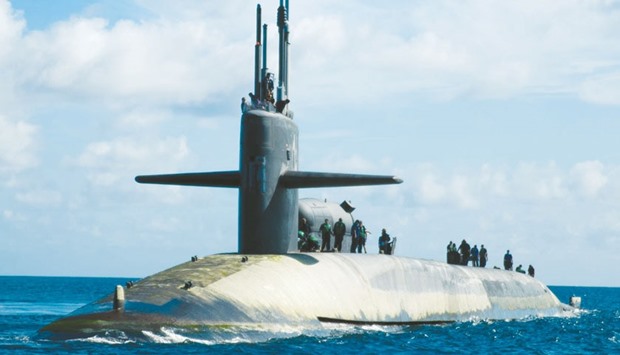US Defence Secretary Ash Carter said yesterday the Pentagon would seek a $582.7bn defence budget next year and reshape its spending priorities to reflect a new strategic environment marked by Russian assertiveness and the rise of Islamic State.
Carter, speaking to the Economic Club of Washington, said the Pentagon’s funding request would be in line with last year’s congressional budget deal but spending would be refocused to address five big challenges facing the US military: Russia, China, North Korea, Iran and Islamic State.
“Today’s security environment is dramatically different than the one we’ve been engaged with for the last 25 years and it requires new ways of thinking and new ways of acting,” said Carter, whose remarks came a week ahead of the formal rollout of the administration’s 2017 budget. The Pentagon’s budget for the current fiscal year is $585bn.
Carter said the Pentagon would seek $7.5bn for the war against Islamic State in the 2017 fiscal year that begins October 1, a 50% increase over spending on the conflict this year.
He said the increase was critical because the United States has used so many smart bombs and laser-guided rockets against the militants in Iraq and Syria that it is running low on the weapons and needs to invest $1.8bn for 45,000 more.
Concerned about Russian aggression against Ukraine and Chinese assertiveness over disputed islands in the South China Sea, the Pentagon plans to increase its investments in advanced weapons to counter the military developments in those countries, Carter said.
“Key to our approach is being able to deter our most advanced competitors,” he said. “We must have - and be seen to have - the ability to impose unacceptable costs on an advanced aggressor that will either dissuade them from taking provocative action or make them deeply regret it if they do.”
Carter said the defence department also planned to invest $71.4bn next year in research and development, much of it aimed at boosting the military’s strategic capabilities.
He said the Pentagon would spend $8.1bn on undersea warfare in fiscal 2017 and more than $40bn in the next five years.
The initiative is aimed at giving the United States the most lethal undersea and anti-submarine force in the world, funding nine Virginia-class submarines built by General Dynamics Corp and Huntington Ingalls Industries Inc , and increasing their capacity from 12 Tomahawk missiles to 40.
The plan also shifts the Navy’s strategy for a new carrier-based unmanned drone to focus more on intelligence-gathering and refueling than combat strike missions, said the sources
The Pentagon’s plan will also underscore the need to fund all three legs of the US strategic deterrent “triad” - a new Air Force bomber, a replacement for the Ohio-class submarines that carry nuclear weapons, and new nuclear-armed intercontinental ballistic missiles, said one of the sources.
Boeing would receive well over $1 billion in new aircraft orders as it seeks to extend production at the company’s St. Louis facility. The navy will request funding for two Boeing F/A-18E/F Super Hornets as part of the fiscal 2017 war budget, and 14 in the fiscal 2018 budget, said one of the sources.
Navy officials also will likely add a request for 12 more Boeing Super Hornets to their annual list of “unfunded priorities” for fiscal 2017, said one of the sources.
Those moves are aimed at filling a shortfall in the number of strike fighters available on aircraft carriers, given delays in the Lockheed F-35 fighter jet programme and longer-than-expected repair times for current Boeing F/A-18 jets.
The five-year budget plan calls for Lockheed to sell a total of 161 F-35 fighter jets to the Navy and Marine Corps - 64 C-model jets that take off and land on aircraft carriers and 97 B-model jets, which can take off from shorter runways and land like a helicopter, according to one of the sources.
The proposal also narrows the mission of a new drone to be built by the US Navy, the sources said.
To reflect the change, the Navy plans to rename the new drone program the Carrier-Based Air Refueling System, or CBARS, instead of the Unmanned Carrier-Launched Airborne Surveillance and Strike (UCLASS) program, said one of the sources.
The drones would have an initial limited strike capability, but more could be added in coming years, the sources said.
Boeing, Lockheed, Northrop Grumman Corp , which makes the unmanned, unarmed X-47B plane that has been tested on US carriers, and privately held General Atomics spent tens of millions of dollars to prepare for the previous tender.

Ohio class missile submarine.


